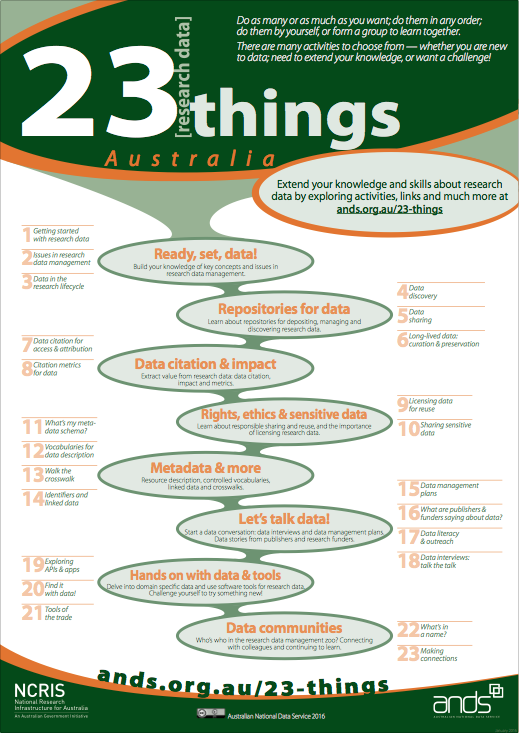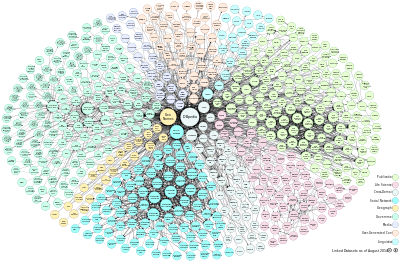Talk:CAA Australia 2017
Contents
Presenters
Robert Haubt is an interdisciplinary researcher and lecturer in Digital Humanities.
Introduction
n/a
Monday Session: Databases
About Database & Knowledge Management
Why is any of this important?
ARC Data Management Requirements Effective data management is an important part of ensuring open access to publicly funded research data. Data management planning from the beginning of a research project helps to outline how data will be collected, formatted, described, stored and shared throughout, and beyond, the project lifecycle. ARC Research Data Management: http://www.arc.gov.au/research-data-management
- Where will your research data be stored at completion of the project?
- What access will you provide to the data set on completion of the project?
- How will you enable others to reuse your research data?
ANDS Guide for ARC Data Management Section: http://www.ands.org.au/guides/arc-guide-to-filling-in-the-dm-section
Australian Initiatives towards Data Management
23 Things
23 (research data) Things is self-directed learning for anybody who wants to know more about research data. If you are a person who cares for, and about, research data and want to fill in some gaps, learn more or find out what others are thinking, then this may be for you!
 http://www.ands.org.au/partners-and-communities/23-research-data-things
http://www.ands.org.au/partners-and-communities/23-research-data-things
Intersect
Intersect is Australia's largest full-service eResearch support agency. We help researchers increase their impact through innovative technologies and expert advice. We work closely with our members and the wider research community to:
- Increase research productivity by decreasing time from hypothesis to tested results.
- Support research diversity by enabling collaborators to share data and experience across disciplines and across organisations.
- Increase research longevity by storing and sharing the long tail of data beyond the research project lifecycle.
Links:
- Co-developing eResearch infrastructure: Technology-enhanced research practices, attitudes and requirements http://www.intersect.org.au/docs/eResearch%20survey%20full%20reportv1.0.pdf
- http://www.intersect.org.au/reports
- http://www.intersect.org.au/news/eresearch-survey-report
The General Process
| Plan | Collect | Process | Analyze | Store | Share | Reuse |
|---|---|---|---|---|---|---|
| ? | ? | ? | ? | ? | ? | ? |
What do we use to plan data collection?
- reuse old data
- collect new data
- new forms
- new applications
What do we use to collect data?
- Notebooks
- Endnote (publications, notes etc.)
- Evernote
- Paper Forms
- Punch Cards
- Audio/Visual Media
- Remote Sensing data
- other technologies
- Apps
- etc.
What do we use Process Data / Store Data?
- Paper Forms
- Punch Card Reader
- Evernote
- Punch Card Reader
- Excel
- Access
- FileMake
- flat
- relational
- extended relational
- object-oriented
- object-relational
- network
- hierarchical
- tripple store
- quad store
- List of Vendors: https://cs.fit.edu/~pbernhar/dbms.html
How do we analyze data?
- sort / categorise
- filter
- query
What do we use to analyze data?
- human-based-computation
- digital-computation
- human-computer-computation
Software:
- dirtdirectory.org
- http://tapor-test.artsrn.ualberta.ca/home
- http://www.visualdataweb.org/relfinder/relfinder.php
Where do we store data?
Desk
- paper forms
Hard Drive
- text
- image
- sound
- 3d
- Excel
Databases
- Access
- Wikis
- Drupal
- Jekyll
- Other
Paid Solutions
- EMu
- Elsevier
- JSTOR
- http://www.getty.edu/conservation/our_projects/field_projects/arches/
- Other
- hard copies
- digital data
- ideas
- Australian Gov.Public Archives
- 19 Heritage Organizations
- 37 Gov. Heritage Bodies
- 15 Non-Gov. Heritage Bodies
- http://www.environment.gov.au/heritage/organisations/
- Interdisciplinary
- Linked Open Data
- Data Repositories
- Local Repositories
- Discipline Specific Repositories
- Research Data Repositories
- Statistics
- Open Access
How do we structure this data so we can make sense of it all?
- Schema
- Thesaurus
- Linked Data
- Metadata
- Ontology
- Inference

